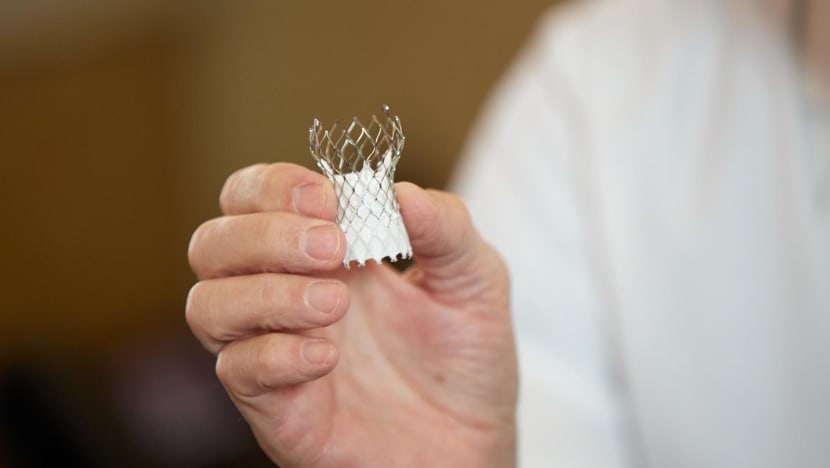A less invasive approach to a heart valve disease
Aortic stenosis is most prevalent among the elderly, but early detection and a wider array of treatment options can help extend life expectancy, says a cardiologist.

According to expert opinion, while heart conditions such as aortic stenosis are considered serious, early discovery allows for effective treatment. Photos: Medtronic, Freepik

This audio is generated by an AI tool.
Many seniors tend to brush off symptoms like chest pain, fainting or shortness of breath during physical activity, thinking it’s just part and parcel of getting older.
However, Dr Ivandito Kuntjoro, a senior consultant and the director of the Structural Heart Programme at the National University Heart Centre, Singapore (NUHCS), cautions that these symptoms, along with excessive fatigue and an inability to carry out routine daily activities can point to a potentially dangerous heart condition – aortic stenosis.
“Seniors aged 70 and above are at the highest risk of suffering from the disease. But many patients with aortic stenosis do not experience notable symptoms until the condition has advanced, making diagnosis challenging,” he noted, adding that a delayed diagnosis, coupled with a lack of treatment, can lead to heart failure and death.
CAUSES AND RISK FACTORS
Aortic stenosis is a heart valve disease resulting from changes to the structure and function of the aortic valve. The latter ensures that oxygenated blood is pumped out from the heart to the rest of body and does not flow back into the heart’s left ventricle, as reverse blood flow could impede the heart’s pumping efficiency.
“As we age, the aortic valve could narrow when calcium builds up around its opening, which restricts blood flow to the rest of the body,” said Dr Kuntjoro.
Although the condition predominantly results from degenerative valve disease (a wear and tear process), other factors such as prior heart valve infections, calcium metabolism disorders, congenital conditions, radiation therapy and other cardiac conditions that bring about alterations in the heart’s structure can lead to aortic stenosis.
He noted that lifestyle factors such as eating a diet high in cholesterol, saturated fats and trans fats, inadequate exercise, excessive alcohol intake and smoking can contribute to the acceleration of the condition.
“Aortic stenosis is one of the most common types of heart valve disease affecting the elderly,” said Dr Kuntjoro. “As Singapore’s population ages, the disease is becoming increasingly prevalent. It’s estimated that moderate or severe forms of the condition occur in 3 per cent of patients over the age of 75, and in 8 per cent of patients above 85 years of age.”
DISTINGUISHING AORTIC STENOSIS FROM OTHER HEART CONDITIONS

Due to shared lifestyle risk factors, aortic stenosis can sometimes be mistaken for myocardial infarction, more commonly known as a heart attack. The latter often arises when blood flow to the heart is reduced or blocked by atherosclerosis, resulting in poor oxygen supply to the heart muscle. Without the prompt restoration of blood flow, the affected heart tissue will die.
Similarly, aortic stenosis-related symptoms can overlap with those of other more common forms of heart disease, such as high blood pressure and irregular heartbeat.
Dr Kuntjoro acknowledges that it may not be easy for a layperson to differentiate between the different types of cardiac conditions. “In any circumstance, it’s imperative not to disregard suspicious symptoms and to seek prompt medical attention. Early diagnosis and intervention are essential for optimal patient outcomes,” he said.
ENHANCING DISEASE MANAGEMENT WITH EXPANDED TREATMENT OPTIONS
When it comes to treating aortic stenosis, Dr Kuntjoro shared that there are a few commonly recommended pathways. However, a crucial caveat is that the only cure for severe aortic stenosis is to replace the damaged aortic valve.
The least invasive line of treatment is medication, which offers temporary relief from symptoms but does not address the underlying valve issue. Over time, its therapeutic effectiveness could also diminish, he added.
Another non-surgical symptom relief option is balloon valvuloplasty. Said Dr Kuntjoro: “However, there is a risk of valve re-stenosis over time, and it is not deemed a long-term solution due to its limited durability.”
When considering surgical approaches, one option is surgical aortic valve replacement (SAVR), a procedure that involves replacing the aortic valve with a mechanical or biological valve.
Dr Kuntjoro explained: “While mechanical valves last longer, patients will need to take blood-thinning medicines perpetually. On the other hand, biological valves need to be replaced after 10 to 15 years.”
He pointed out that SAVR is an open-heart procedure that carries inherent risks, especially for elderly patients and those with underlying medical conditions, and may not be suitable for all candidates. “Additionally, patients who undergo SAVR typically spend a minimum of seven days in hospital before embarking on a prolonged path to recovery,” he said.
The latest addition to the treatment of aortic stenosis is transcatheter aortic valve implantation (TAVI).

A small incision is made, often at the patient’s groin, through which a thin, flexible tube carrying an artificial valve is guided via a catheter into the heart, where it is implanted to replace the patient’s diseased aortic valve. The procedure is performed under local anaesthesia.
As it is a minimally invasive procedure, TAVI is suitable for patients who are considered high-risk or unsuitable for open-heart surgery, such as those with multiple medical issues or poor heart function, said Dr Kuntjoro.

According to recent reports, TAVI patients generally experience shorter hospital stays, with an average duration of about two to three days.
He highlighted, “As every patient is different, it’s essential to have a thorough discussion about the most suitable treatment approach with your attending physician.”
EARLY DETECTION FOR BETTER HEALTH OUTCOMES
Dr Kuntjoro recommends that older individuals who are at risk of aortic stenosis increase their chances of early detection by undergoing regular cardiac screenings, such as an electrocardiogram or echocardiogram.
“Caregivers should also ensure that seniors exercise regularly and eat a balanced diet,” he said.
Dr Kuntjoro emphasised that while aortic stenosis is considered a serious condition as heart valve damage is irreversible, early discovery allows for effective treatment.
“Advancements in technology mean that newer procedures such as TAVI are now available,” he said. “The latter allows patients to resume their regular lifestyles post-surgery without having to live with debilitating symptoms.”
If you or a loved one is at risk for aortic stenosis, schedule regular heart check-ups. Early detection and treatment of heart valve disease can help seniors age well in their golden years. For information, visit the National University Heart Centre, Singapore.















